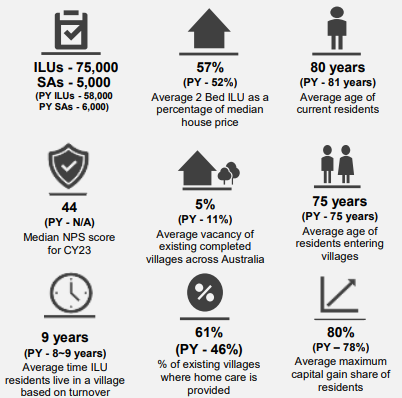
Residents moving in older, staying longer and holding operators in high regard
- Categories Latest industry developments
- Date July 11, 2024
In 2015, the PwC/Property Council Retirement Census stated the average age of village residents moving into a retirement village was 74 years old.
The 2023 Census, released last week, stated the average age of entry is now 75. While the average age of entry hasn’t moved, year on year, it is interesting to reflect on the longer-term trends of the data collected by PwC, and reported on jointly with the Property Council for close to a decade.
The most recent snapshot report was launched by the Retirement Living Council’s Executive Director, Daniel Gannon, and Aveo CEO, Tony Randello, last week, at Aveo’s The Clayfield community in Brisbane.
“This Census data offers crucial benchmarking for retirement living operators and it confirms that in the midst of a housing crisis, retirement living communities continue to serve as an affordable housing option where older Australians can thrive,” said Tony Randello.
Tony referred to key findings from the most recent Census, which revealed:
- A two-bedroom unit in a retirement village is on average 43 per cent cheaper than the median house price in the same postcode.
- The average cost for a unit in a retirement village is $559,000 compared to the $986,000 median house price in the same postcodes.
- Retirement villages are effectively operating at full capacity, with five per cent vacancy.
“Retirement villages are an affordable housing solution available to older Australians in an otherwise unaffordable housing market,” Daniel Gannon said.
Village residents are staying longer
The 2015 Census reported the average stay residents stayed in a retirement village was seven years. In 2023, this was nine years.
Equally, the number of retirement villages providing home care has increased substantially. 61% of existing villages compared to 46% the previous year.
These statistics support what Village Professionals around the country already know.
The care and support being provided to residents across the country is increasing. This in turn delays their entry into aged care.
Net Promoter Score is +44
The 2023 Census reported the high regard with which retirement village residents hold operators – with a national Net Promoter Score (NPS) of +44.
NPS is an internationally recognised metric used to measure customer loyalty and satisfaction. It’s calculated by asking customers how likely they are to recommend a company or service to others on a scale of 0 to 10.
A score of +44 for retirement villages, indicates a high level of resident satisfaction and loyalty, comparable to and even surpassing several other sectors. This positive score reflects well on the quality of services provided by operators and Village Professionals, and overall life in retirement villages.

Australia's largest professional development for village and community manager and head office staff.



